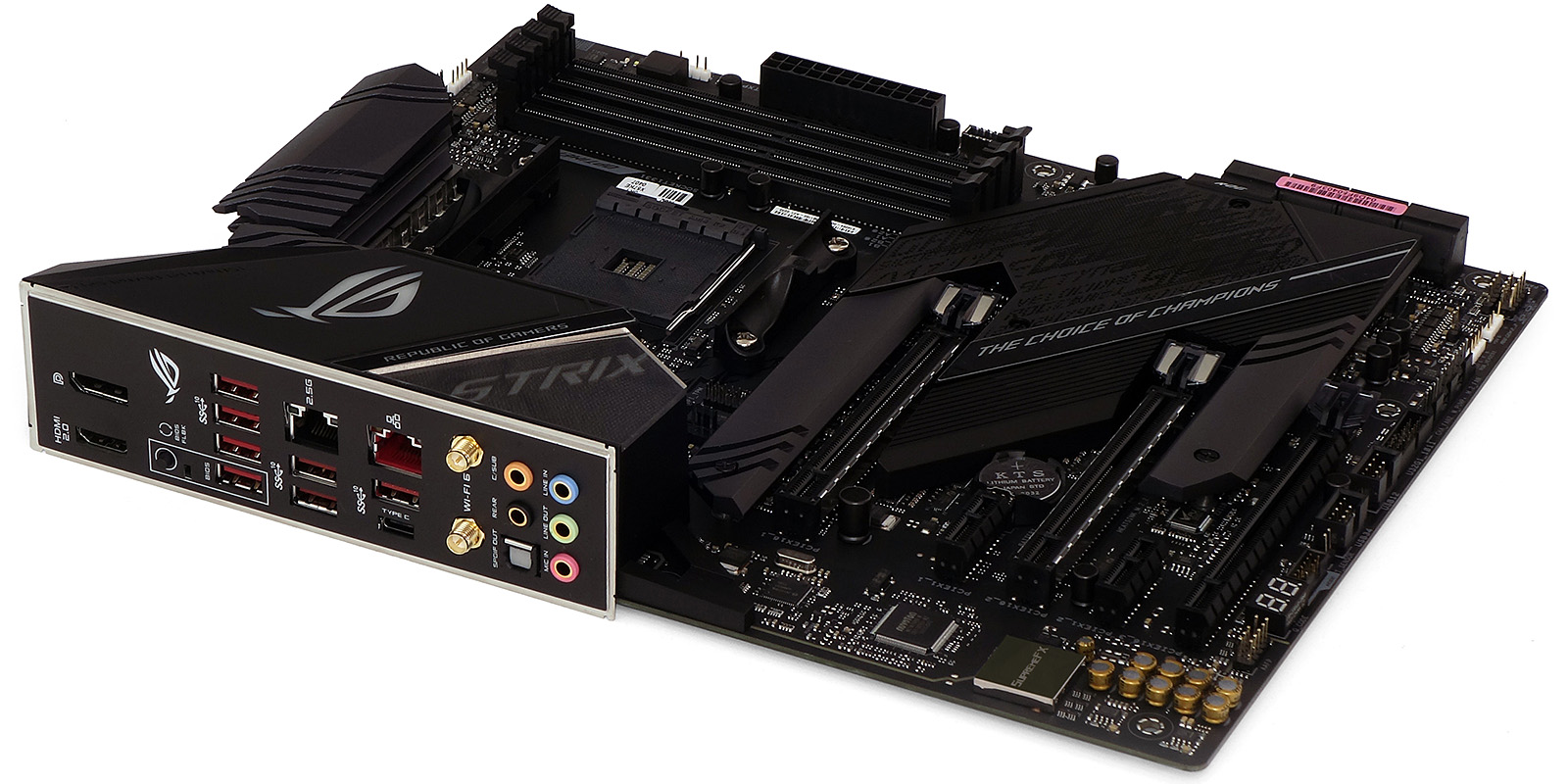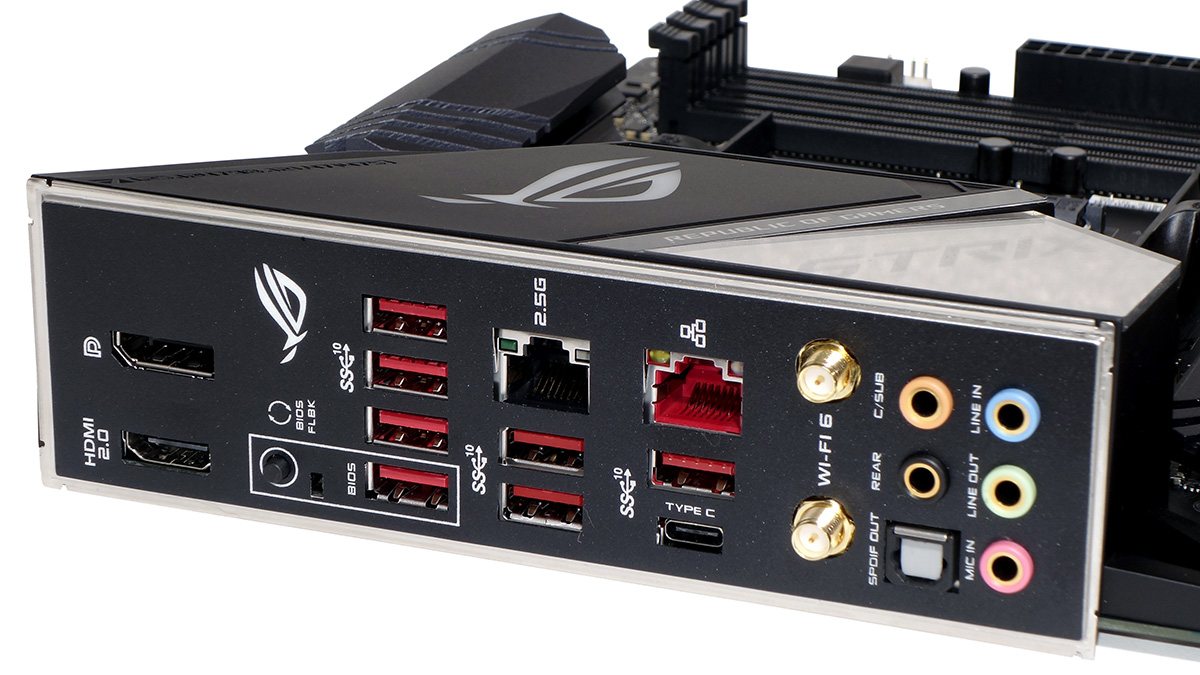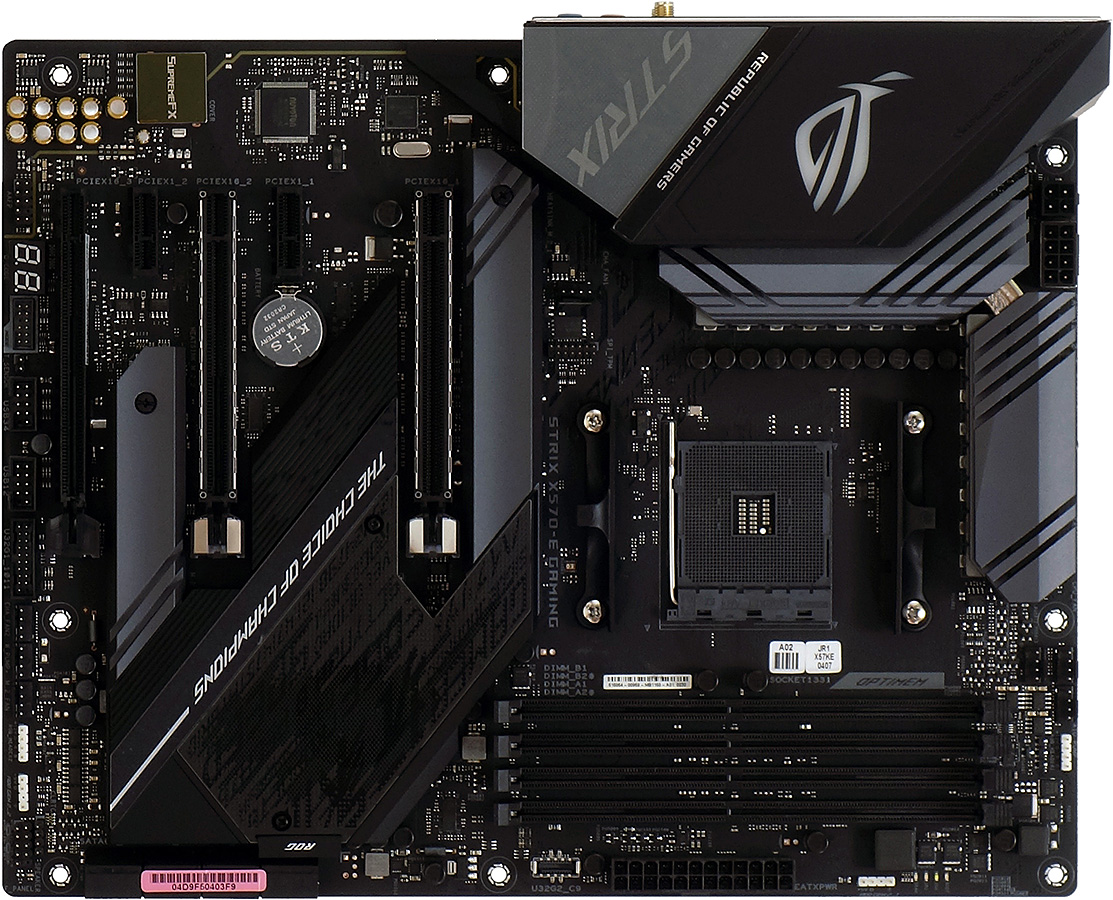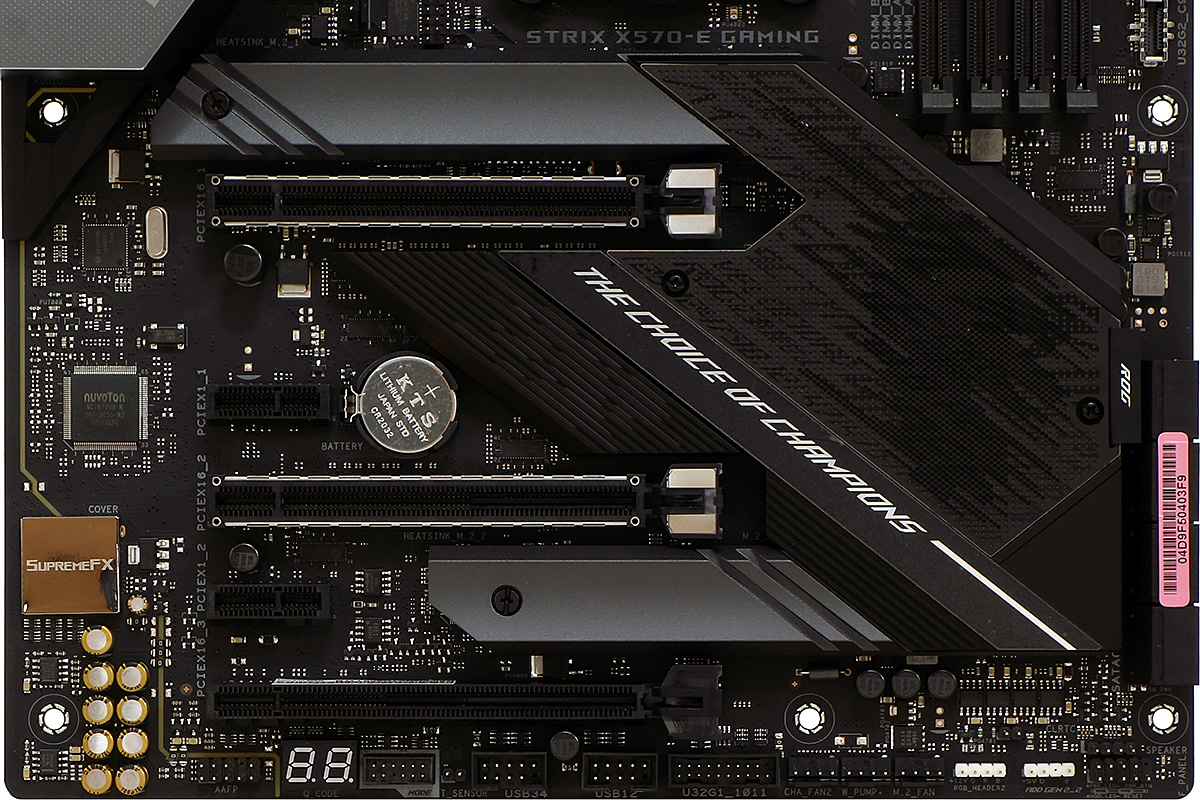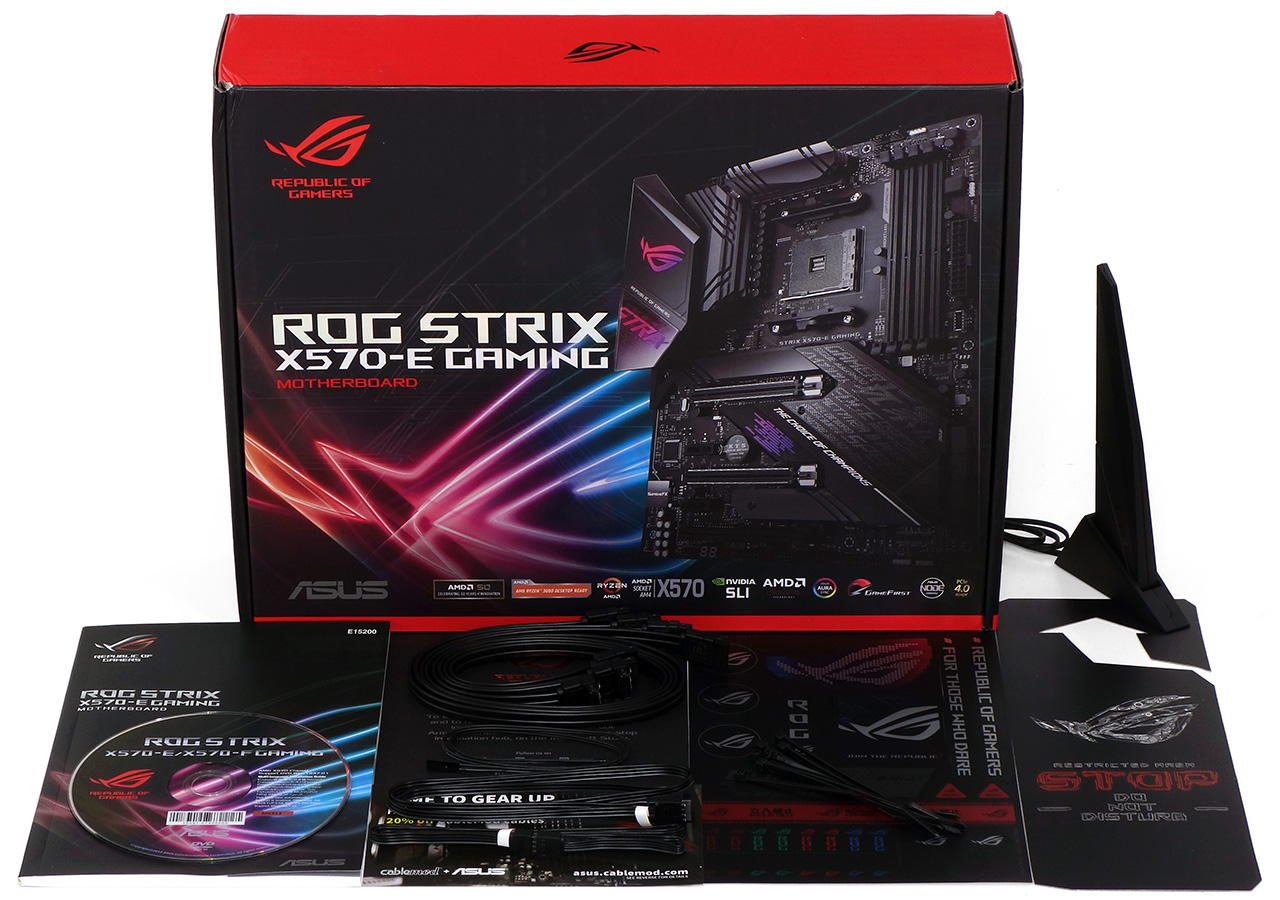Tom's Hardware Verdict
With only two M.2 slots but eight I/O-panel USB3 Gen2 and eight SATA ports, the Asus ROG Strix X570-E Gaming is more of a power-user board than a gamer. But compared to competing models, its lower price and robust feature set makes it easy to recommend among early X570 offerings.
Pros
- +
+ More USB3 Gen2 ports than competitors
- +
+ Good overclocking
- +
+ 2.5GbE plus Gigabit Ethernet plus WiFi 6
- +
+ Cheaper than competing boards with above features
Cons
- -
Only two M.2 connectors
- -
Efficiency could be better
Why you can trust Tom's Hardware
Who needs eight 10Gbps USB ports on the I/O panel? With all of the X570 platform’s USB 3.x ports offering that bandwidth, a better question might be why Asus’s competitors (specifically the MSI MEG X570 Ace, Gigabyte X570 Aorus Master and ASRock X570 Taichi) are substituting some of those with 5Gbps ports. But who would be willing to give up one of the competitor’s three M.2 slots for four SATA ports? If that sounds like you, the ROG Strix X570-E Gaming ($330 / £326) beckons. With these features nailed down, the only remaining question is why Asus labels this board “gaming” rather than “pro.”
We've tested several X570 boards, including some models refreshed for AMD's new Ryzen 5000 CPUs but only a handful of models stand out enough to rank among our Best Motherboads list.
- Visit our motherboard basics and motherboard buying guide to help you narrow down your board buying options.
Asus ROG Strix X570-E Gaming Specs
| Socket | AM4 |
| Chipset | AMD X570 |
| Form Factor | ATX |
| Voltage Regulator | 16 Phases |
| Video Ports | DisplayPort, HDMI |
| USB Ports | 10Gbps: (7) Type-C, (1) Type A |
| Network Jacks | 2.5GbE, Gigabit Ethernet, (2) Wi-Fi Antenna |
| Audio Jacks | (5) Analog, (1) Digital Out |
| Legacy Ports/Jacks | ✗ |
| Other Ports/Jack | BIOS Flashback Button |
| PCIe x16 | (3) v4.0 (x16/x0/x4, x8/x8/x4)(*x2 mode when 2nd PCIe x1 is filled) |
| PCIe x8 | ✗ |
| PCIe x4 | ✗ |
| PCIe x1 | (2) v4.0 (2nd shared with PCIe x16-3) |
| CrossFire/SLI | 3x / 2x |
| DIMM slots | (4) DDR4 |
| M.2 slots | (2) PCIe 4.0 x4 / SATA |
| U.2 Ports | ✗ |
| SATA Ports | (8) 6Gb/s |
| USB Headers | (1) v3.x Gen2, (1) v3.x Gen1, (2) v2.0, (1) AMD fan LED |
| Fan Headers | (7) 4-Pin |
| Legacy Interfaces | System (Beep-code) Speaker |
| Other Interfaces | FP-Audio, Asus NODE, Thermistor, (2) RGB LED, (2) ARGB LED |
| Diagnostics Panel | Numeric |
| Internal Button/Switch | ✗ |
| SATA Controllers | Integrated (0/1/10) |
| Ethernet Controllers | RTL8125AG PCIe, WGI211AT PCIe |
| Wi-Fi / Bluetooth | Intel AX200 802.11ax (2.4 Gb/s) / BT 5.0 Combo |
| USB Controllers | ✗ |
| HD Audio Codec | ALC1220 |
| DDL/DTS Connect | ✗ |
| Warranty | 3 Years |
Asus ROG Strix X570-E Gaming Features
Motherboard designers typically go for obvious choices: When AMD announced that its latest platform would support one NVMe M.2 drive from the CPU and up to 16 high-speed connections from the X570 PCH, it was obvious that most manufacturers would deploy twelve of those PCH lanes as a second and third M.2 interface plus a PCIe x4 slot. Those designers were then left to figure out whether to use those final four lanes for SATA, USB3 or additional PCIe. And that’s where lane sharing that disables one interface to enable another begins. Asus took a different track in its ROG Strix X570-E Gaming: It has only two M.2 slots total.
The Strix X570-E Gaming also has eight SATA ports, whereas some competing models have shaved those down to four so that the other four lanes could be used for PCIe (typically a third M.2 slot). And just when you thought you’d at least get four lanes to the third x16-length PCIe slot, you realize that it gets kicked down to x2 mode whenever the second x1 slot is used. Most people won’t use the second x1 slot because of its location, but that notion makes us question why it’s even included on a gaming-focused motherboard.
Asus’s efforts appear more earnest on the I/O panel, where we find eight USB3 Gen2 ports. Gen1 ports wouldn’t make sense here from a chipset perspective, since the platform’s USB3 ports are all Gen2 compliant, yet several of Asus’ competitors have chosen to limit their I/O anyway. We’re happy to see Asus take the high road here, though we’d have still liked to see a pair of USB 2.0 ports for a keyboard and mouse -- connecting those to USB3 is a waste of the platform’s resources.
USB support is the big differentiator here, since Asus uses the same Realtek 2.5Gbps/Intel Gigabit Ethernet/802.11ax controller combo as similarly-priced boards from Gigabyte and MSI, but there are smaller differences such as the inclusion of DisplayPort and HDMI and the exclusion of a CLR_CMOS button on this Asus board, along with four more SATA ports and one less M.2 slot than those two competitors.
Perhaps it’s the association between gaming and overclocking that earns the Strix X570-E Gaming its name. From above we see sixteen chokes that are each tied to a 50A MOSFET in a 12+4 arrangement, meaning that users could push up to 600A of current to the CPU core. We also see three 4-pin fan headers at the top edge, three at the bottom edge, and one forward of the I/O panel’s audio jacks to help those who build for overclocking to keep everything cool. And let’s not forget the two RGB and two ARGB headers, repeated at the top and bottom of the board, that could be used to control fan lighting (in addition to RGB strips, of course).
Get Tom's Hardware's best news and in-depth reviews, straight to your inbox.
Looking at the Strix X570-E Gaming’s lower half, we see that the PCH cover is mesh and secured with two screws. Unfortunately, that cover must be removed to access the forward screws of the two M.2-drive heat spreaders. Anyone who doesn’t need those heat spreaders can ease M.2 access by leaving them off, which then makes removing the PCH fan cover unnecessary.
Front-panel audio, Asus Node, thermistor, two USB 2.0 and one USB3 Gen1 dual-port, three fan, RGB ARGB, Intel-style front-panel button/switch, and a beep-code speaker header line the Strix X570-E Gaming’s bottom edge, while the single-port USB3 Gen2 front-panel header sits halfway up its front edge. Also found on the bottom edge is a two-digit status code display.
The Strix X570-E Gaming includes a multi-language user manual, driver and application disc, four SATA cables, a thermistor lead, and RGB and ARGB extension cables. Also included is a thank-you card, a Cablemod coupon, an ROG sticker sheet, several cable ties, a 2T2R Wi-Fi antenna, and a hanging doorknob card.
Image Credits: Tom's Hardware
MORE: Best Motherboards
MORE: How To Choose A Motherboard
MORE: All Motherboard Content
-
rolli59 Good review but still awaiting reviews of sub $200 boards,Reply
Have been building for years and never needed a board over $150. -
Crashman Reply
With X570 you'll be saying you never needed a board over $200 :) We have someone working on that for you.rolli59 said:Good review but still awaiting reviews of sub $200 boards,
Have been building for years and never needed a board over $150. -
Badelhas Good review but these x570 motherboards are way too expensive, in my opinion. I wont buy a 300+ motherboard to go with the 200$ Ryzen 3600...Reply
When will Toms Hardware make an analysis of the current situation when pairing the great value Ryzen 3600 with the cheaper B450 options motherboards?
Cheers -
rafaelramax Thanks for the great review!Reply
I guess this is a solid competitor of its class. There are few minor flaws, like the lack of CMOS reset button on the rear and those dull M.2 covers. Asus did a good job here overall. Some smart moves like splitting the Fan headers across the board and providing the SATA ports in a 90º placement helps with cable management, maintenance, air flow and even aesthetics. I get the feeling that there are some disposable things that could get the price a little lower, hence the video outputs and the heatsinks-everywhere approach should be revisited. Each mobo of this tier tend to offer somewhat distinct set of features. This one clearly appeals to the all USB3.x and 8 SATA ports while very budget-oriented.
I was expecting an even more detailed analysis over the Power Delivery solution implemented on this mobo. I'm far from an expert, but Asus seems to adopt rather different scheme than other brands while not using doublers nor true independent phases either. Following power stage MOSFETs are rated to higher current and lower voltage in a two-per-phase design against the "true independent 12+2 phase" with one-per-phase MOSFET on the similarly priced Gigabyte Aorus Master. I wanted to see how either solution would fare against each other concerning stability and overclocking capabilities as there is too few updated info regarding this theme. The recent Aorus Master review pointed a slightly lower clock on (apparentely) the same piece of 3700X, but I think that are much more to be covered. I would like to know how the same CPU and RAM can be OC'd on each board with same voltage would be useful.
There are lots of issues I dislike about this trending marketing side of components and all mobos are included. Options are scarce for high-performance full-feature parts that doesn't add up a ton of aesthetic, illumination, bundled RGB and further RGB support, military, racing, gaming themes, with everything glowing. I always have to choose between getting features or getting plain elegant looks. That just proves that brands have terrible tastes. I really wanted to see the same products sporting sleek clean visuals versions, with no RGB whatsoever. The sole offer from Asus is the professional-grade with WS X570-ACE, but on higher price point than this Strix X570E, yet not as capable feature-wise. They just push this garbage along with their finest products to inflate prices and this is ridiculous. When those manufacturers mix that policy with this new platform we are presented to this inflated price scenario for Mobos. The cheapest X570 Mobos came with an outrageous MRSP US$200 that adds up nothing but PCIe4 and a always weird chipset fan. Many of those entry-level Mobos offer below average VRMs, USB/Sata/Fan ports count, connectivity options, with terrible Audio codecs. Speaking of PCIe4, the bandwidth uplift is useful only for already-announced-yet-soon-to-be-released SSDs, not even the recently launched GPUs will benefit from it. Previous generation Mobos with similar perks at launch were found for half the current price and that is infuriating. Opting to ditch my then US$150 Mobo will cost me US$300 to keep specs alike. This is roughly the distance between a 3700X and a 3900X.
With that in mind, I would like to suggest if you could provide us with more extensive analysis when pairing the new Zen2 arch with the mainstream boards equipped with older gen chipsets, like the B350, B450, X370 and X470. There's few content of the matter and, at least for me, it will be extremely useful. I was totally on the hype for Zen2 and was planning to replace my 2 years old 1700 with a 3700X. I didn't get one yet mostly because of availability and price of Mobos in my region and now I'm not even considering the X570 platform anymore. I guess many users are facing the same dilemma now.
Cheers! -
suddenstop Does the MSI board show the fastest memory overclock and then the lowest memory bandwidth? Can anyone explain that?Reply -
Crashman Reply
Secondary and tertiary timings are the most likely culprit: MSI uses more-stable timings so that the memory will overclock higher. When using a program that measures how fast a large number of packets are sent and received to rate bandwidth, the wait time between sends and receives impacts the bandwidth rating.suddenstop said:Does the MSI board show the fastest memory overclock and then the lowest memory bandwidth? Can anyone explain that?
This is how the MSI motherboard ended up being the one we used in memory reviews without being the one we picked for an award in this price class. The higher overclocks are better for memory reviewers than for actual users. -
Bagman 1972 I can't understand people and the reviewer balking at the lack of USB 2.0 ports on the back plate. They can be added so easily off the motherboard USB 2.0 header to the back of the case.Reply -
Crashman Reply
The argument against those who hate USB 2.0 is that it's a nearly-free interface that fully supports a keyboard and mouse. There's no reason to use more expensive parts to support two devices that nearly everyone uses.Bagman 1972 said:I can't understand people and the reviewer balking at the lack of USB 2.0 ports on the back plate. They can be added so easily off the motherboard USB 2.0 header to the back of the case.

